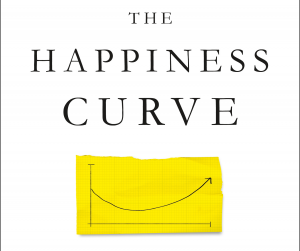The Happiness Curve
If you’re entering your 40’s and you’re thinking that life can’t get any worse – well it does.
Let me assure you that life does getter once you round the 50 year old corner. That’s the message of the book The Happiness Curve by Jonathan Rauch.
The book if full of personal stories of people Rauch interviewed. They are many different ages and some were interviewed at different ages.
He also interviewed an economist, psychologists, and neuroscientists as well as “social thinkers and reformers who are exploring and mapping a whole new state of adult development.”
To quote Rauch’s own description of his book:
“The book is about new light being cast on happiness by the dismal science, economics. It is about the frequently perverse behavior of life satisfaction, which has less to do with our material circumstances and accomplishments than we imagine.”
I didn’t know that there was so much extraordinarily interesting information on the subject but turns out there is. It gives us enough actual behavioral science and studies to keep the most intellectually curious satisfied but not so much that the rest of the reading audience would start skipping ahead to find other interesting bits.
Personally, I read every word of the book because I was resonating with the message and I wanted to know more about the curve. I wanted to understand why I had experienced exactly the swings down and back up during those midlife years.
Some Midlife Myths
According to The Happiness Curve Press Kit these are some of the Midlife Myths that the book debunks – but be aware that nothing is 100% true for everyone and that’s also the case here. I’m including the complete text of the myths because each one is so important to know and understand.
-
Myth: Youth is the most glorious time of life
- Fact: Emotional regulation improves with age
-
Myth: Getting old is stressful
- Fact: Stress declines steadily after about the age of 50, and contentment becomes easier to achieve
-
Myth: Getting old is depressing
- Fact: The elderly are no more depressed than anyone else. In fact, aging makes us less regretful and more inclined to look on the bright side. This “positivity effect” shows up in brain scans.
-
Myth: Getting rich will make me happy
- Fact: Strong and trusting connections to others are what will make you happy. The key to contentment is community, not competition.
-
Myth: Achieving my goals will make me happy
- Fact: We’re wired to be dissatisfied strivers, always looking ahead to the next goal and often disappointed with our best accomplishments–until later adulthood, when gratitude starts to come easier and we shift toward other-directed priorities that furnish deeper satisfaction
-
Myth: Midlife crisis makes people behave foolishly and self-indulgently–e.g., by breaking up their marriage and buying a sports car
- Fact: For most people, midlife malaise is a long, quiet slog as happiness gradually sinks and then just as gradually rises
-
Myth: We’re turning into a nation of graying retirees
- Fact: Older adults are healthier, happier, and have more to give than ever before, and they and society are already starting to invent new ways for them to contribute. The old black-and-white distinction between work and retirement is giving way to the mixed pursuits of “encore adulthood.”
-
Myth: Malaise in my forties must mean I’m doing something wrong and need to fix my life
- Fact: Humans are wired to be less optimistic and more disappointed in midlife. Dissatisfaction in your forties is not necessarily “about” anything. It’s a natural, normal emotional reboot that nudges your values away from competition and toward community
Humans Aren’t the Only Ones
Interestingly, chimpanzees and orangutans also have this same hardwired happiness curve. There have been multiple studies where they found that these “great apes” experienced the same U-shaped curve as they lived their lives.
The main difference is the age at which the apes hit the bottom of the U compared to humans. The apes have a shorter lifespan and so their curve starts going up in their 40’s instead of the 50’s as it is for humans. Otherwise, it is very similar and seems to be hardwired just like in humans.
My Summary
I am definitely recommending this book to anyone who is interested in the study of human behavior or just wants to know when they will start coming out of the fog and into the still waters and sunshine. The author Rauch says himself that when the fog lifted it wasn’t because he had done anything except gotten older.
Rauch writes well and it is easy reading. I sometimes had to go back to remind myself who someone was when they reappeared later in the book but that’s me. I found it very valuable and I loved being able to learn something about myself. That aha! moment is always welcome in a non-fiction book.
Making the turn and going back up the curve really isn’t something we can speed up. But, understanding that it will happen and probably sooner rather than later gives you a ray of hope in the dark days of midlife. I will also add that from personal experience it does keep getting better once you make it round the curve.
If you want to buy your own copy of The Happiness Curve click here or borrow it from your local library. I’m sure they have it, that’s where I read it the first time before I decided to buy it for myself.

1 Response to "Things Get Better at 50!"
Great review! Thanks for sharing!